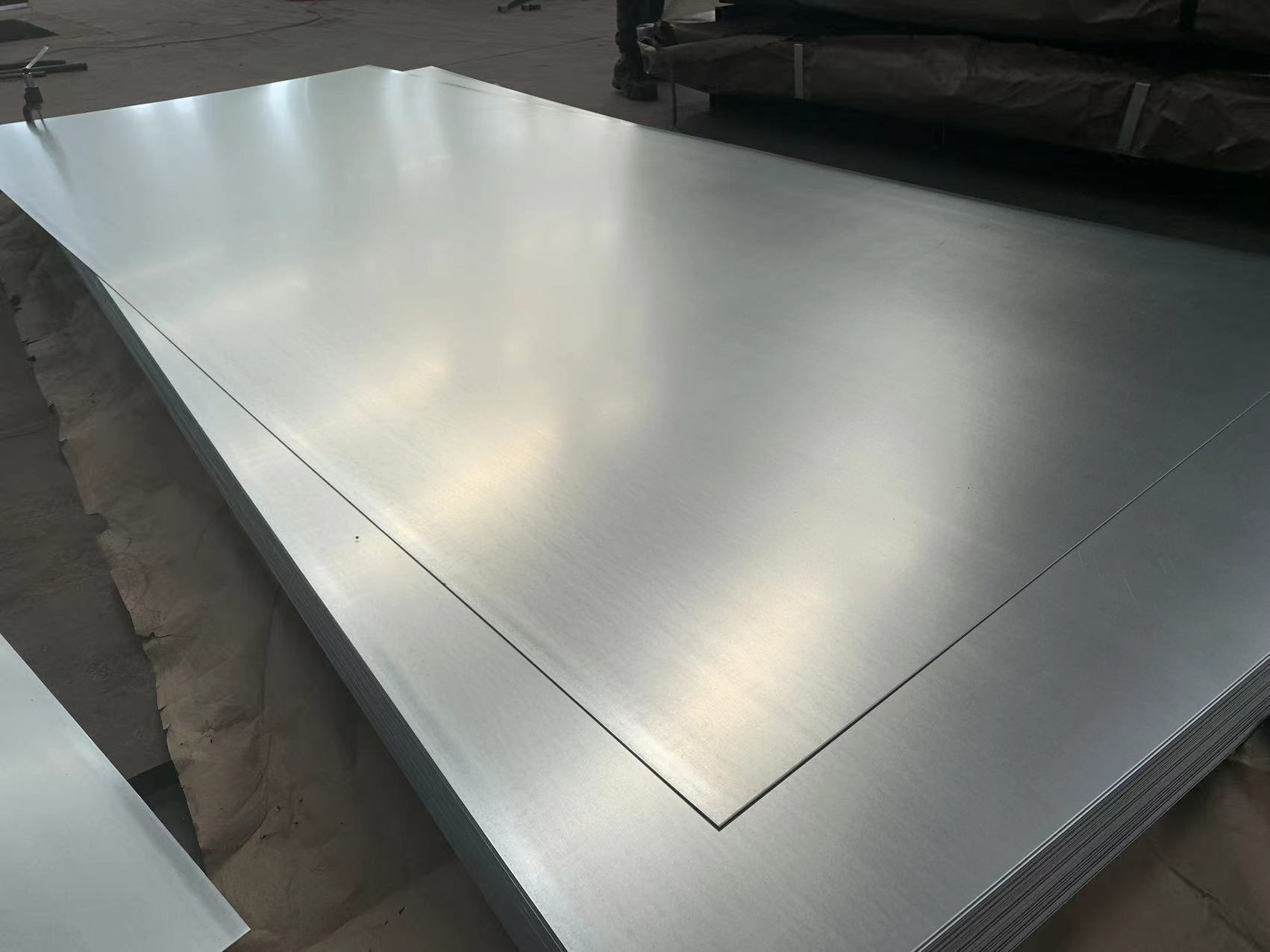Understanding Galvanization and Its Purpose
What is Galvanized Sheet Metal?
Galvanized sheet metal is a type of steel that has been coated with a layer of zinc to enhance its durability and resistance to rust. This protective layer is applied through a process known as galvanization, which serves the purpose of safeguarding the metal from environmental elements that could lead to corrosion. Galvanized sheet metal is commonly used in a variety of industries including construction, automotive, and home improvement, owing to its robust and long-lasting properties.
The Process of Galvanization
The process of galvanization typically involves the hot-dip method, where the steel sheet is submerged in a bath of molten zinc. This process ensures that the zinc coating adheres uniformly to the surface of the metal, creating a barrier that not only protects against rust but also adds an extra layer of hardness. The end result is a metal sheet that combines the toughness of steel with the anti-corrosive properties of zinc, making it an ideal material for diverse applications where durability is essential.
Benefits of Using Galvanized Sheet Metal
There are numerous benefits to using galvanized sheet metal, the foremost being its superior resistance to rust and corrosion. This durability makes it a cost-effective choice in the long run as it requires less maintenance and has a longer lifespan compared to non-galvanized metals. Additionally, galvanized sheet metal offers excellent aesthetic appeal with its shiny, spangled finish, which not only looks attractive but also provides added protection. The versatility of galvanized metal makes it suitable for a wide range of uses from roofing and gutters to automotive parts and outdoor sculptures.
Waterproofing Properties of Galvanized Sheet Metal
How Galvanized Coating Protects Against Water
The zinc coating on galvanized sheet metal acts as a sacrificial layer, ensuring that water and moisture do not come into direct contact with the steel underneath. Zinc, being more reactive than steel, oxidizes first when exposed to water and air, forming a protective layer of zinc oxide that prevents further oxidation of the underlying metal. This makes galvanized sheet metal an effective barrier against the damaging effects of water, keeping the metal structurally sound over extended periods.
Comparing Waterproof Capabilities with Other Metals
When compared to other metals such as aluminum or stainless steel, galvanized sheet metal holds its ground remarkably well in terms of waterproofing. Aluminum, while resistant to rust, can corrode when exposed to saltwater environments and certain industrial chemicals. Stainless steel offers excellent corrosion resistance but comes at a significantly higher cost. Galvanized sheet metal strikes a balance by providing reliable protection against water at a more affordable price point, making it a popular choice for a variety of applications where waterproofing is crucial.
Common Applications Where Waterproofing is Essential
Galvanized sheet metal is widely used in scenarios where waterproofing is critical. One of the primary applications is in the construction of roofing systems that need to withstand heavy rainfall and snow. Other common uses include gutters and downspouts, which facilitate effective water drainage around buildings. In industrial settings, galvanized sheet metal is often employed in making storage tanks and silos that must endure prolonged exposure to moisture. Additionally, it is a favored material in marine environments for making docks and buoys, where consistent water exposure is a given.
Factors Influencing the Durability of Waterproofing
Environmental Factors and Exposure
The durability of the waterproofing properties of galvanized sheet metal largely depends on the environmental conditions it is exposed to. Various factors such as temperature extremes and humidity levels play a significant role in determining how well the protective zinc layer performs over time.
Temperature Extremes
Extreme temperatures can affect the integrity of the zinc coating on galvanized sheet metal. Prolonged exposure to intense heat may cause the zinc layer to break down more quickly, reducing its effectiveness in protecting the underlying steel. Conversely, extremely low temperatures can make the metal more brittle and susceptible to cracking, which can compromise its waterproofing properties. It is essential to consider these temperature fluctuations when choosing galvanized sheet metal for specific applications, particularly in regions with harsh climate conditions.
Humidity and Moisture Levels
High humidity and constant exposure to moisture can accelerate the corrosion process, even in galvanized sheet metal. While the zinc coating provides substantial protection, persistent moisture can eventually penetrate the layer, especially if there are any pre-existing cracks or damages. Therefore, environments with high humidity, such as coastal areas or industrial zones with high moisture levels, can influence the lifespan and effectiveness of the waterproofing capabilities of galvanized sheet metal. Regular maintenance and inspection can help mitigate some of these risks and extend the durability of the material in such conditions.
Physical Wear and Tear Over Time
Even with a robust zinc coating, galvanized sheet metal can experience physical wear and tear that may affect its waterproofing capabilities. Regular usage and exposure to various elements can lead to scratches, dents, and abrasions on the metal surface. Over time, these physical damages can compromise the integrity of the zinc layer, making it less effective at preventing water ingress. It’s crucial to monitor the condition of galvanized sheet metal, particularly in high-use or high-traffic areas, and address any damages promptly to maintain its waterproof properties.
Maintenance Practices to Enhance Lifespan
To extend the life of galvanized sheet metal and its waterproofing efficiency, consistent maintenance practices are vital. Regular cleaning to remove dirt, grime, and other contaminants can prevent these substances from causing surface corrosion. Applying a protective sealant can also add an extra layer of defense against water and environmental factors. Additionally, promptly repairing any scratches or damages can prevent them from worsening and compromising the metal’s integrity. When these maintenance practices are followed diligently, the lifespan of galvanized sheet metal can be significantly extended.
Testing and Certification Standards for Waterproofing
Industry Standards and Regulations
The waterproofing properties of galvanized sheet metal are subject to various industry standards and regulations to ensure their reliability and effectiveness. Standards such as ASTM (American Society for Testing and Materials) and ISO (International Organization for Standardization) outline specific criteria for coating thickness, adhesion, and corrosion resistance. Compliance with these standards not only assures that the galvanized metal meets a certain quality level but also provides confidence to consumers and industry professionals about its waterproofing capabilities. Adherence to these regulations is crucial for maintaining the material’s performance in various applications.
Methods to Test Waterproofing Efficiency
Several methods are used to test the waterproofing efficiency of galvanized sheet metal. One common test is the salt spray test, which simulates long-term exposure to a corrosive environment to evaluate how well the zinc coating protects the steel. Another method is the electrochemical impedance spectroscopy, which measures the resistance of the coating to electrical current, indirectly assessing its integrity and waterproofing properties. Additionally, field tests that involve real-world exposure under controlled conditions can provide valuable insights into the material’s performance over time. These testing methods collectively contribute to a comprehensive understanding of the waterproofing efficiency of galvanized sheet metal.
Practical Tips for Enhancing Waterproofing in Galvanized Sheet Metal Applications
Proper Installation Techniques
Proper installation is paramount in ensuring the waterproofing efficiency of galvanized sheet metal. When installing, it is essential to seal all gaps and joints meticulously to prevent water ingress. This can be achieved by using high-quality sealants and ensuring that all fittings are tight and secure. Additionally, using compatible fasteners made of materials that do not compromise the zinc coating is crucial. Incompatible materials can cause galvanic corrosion, leading to premature failure of the protective layer. Following these installation best practices helps in maintaining the integrity and waterproofing properties of the metal.
Regular Inspection and Maintenance Practices
Regular inspection and maintenance play a vital role in preserving the waterproofing capabilities of galvanized sheet metal. Scheduled inspections can help identify early signs of corrosion, physical damages, or compromised areas that may require attention. Routine cleaning to remove buildup of dirt, pollutants, and other contaminants can also prevent them from affecting the metal’s surface. Implementing protective coatings or repainting when necessary can further extend the metal’s lifespan. By incorporating these proactive measures, the long-term effectiveness of galvanized sheet metal’s waterproofing can be maximized.
Real-World Applications Showcasing Effectiveness
Residential Uses: Roofing, Gutters, and Siding
In residential settings, galvanized sheet metal is commonly used for roofing, gutters, and siding due to its excellent waterproof properties. In roofing, it provides a sturdy and water-resistant barrier that protects homes from rain and snow. Gutters made from galvanized metal ensure efficient water drainage, preventing water damage to the building’s foundation. For siding, the material offers both aesthetic appeal and functional protection against moisture. Such applications exemplify how galvanized sheet metal performs effectively in protecting residential structures from water-related damage.
Industrial Uses: Construction, Marine Environments, and Agricultural Structures
Galvanized sheet metal proves to be highly effective in various industrial applications where waterproofing is crucial. In construction, it is used for structural frameworks, protective claddings, and drainage systems. For marine environments, the metal’s resistance to saltwater corrosion makes it ideal for docks, buoys, and other maritime structures. In agricultural settings, galvanized sheet metal is utilized in constructing silos, barns, and irrigation systems, providing durability and resistance to the elements. These real-world applications highlight the versatility and reliability of galvanized sheet metal across different industries.
Final Thoughts on the Waterproof Efficiency of Galvanized Sheet Metal
In conclusion, galvanized sheet metal offers exceptional waterproofing properties, driven by its robust zinc coating that acts as a sacrificial barrier against water and moisture. While various environmental factors and physical conditions can impact its durability, adopting proper maintenance and installation practices can significantly enhance its lifespan. Considering its cost-effectiveness, compliance with certification standards, and proven performance in both residential and industrial applications, galvanized sheet metal remains a highly reliable material for waterproof purposes. For those seeking a balance between durability, affordability, and effective waterproofing, galvanized sheet metal stands out as an optimal choice.
Sunrise New Materials is an international and professional supplier of steel and non-ferrous metal raw materials. They are committed to providing reliable and customized supply solutions for steel and metal products to global users. As a one-stop supplier, they have become the preferred choice for tens of thousands of customers worldwide.
Sunrise New Materials offers a wide range of products, including galvanized sheet metal. The galvanized sheet metal they provide is made from materials such as SGH340, SGH400, SGH440, SGH490, SGH540, DX51D, DX52D, DX53D, DX54D, S220GD, S250GD, S280GD, S320GD, S350GD, S400GD, S500GD, and S550GD. The thickness of the sheet metal ranges from 0.12mm to 2.5mm, and the width is from 600mm to 2500mm. The length can be customized according to the client’s request.
In terms of coating, the galvanized sheet metal is coated with AZ30g to 275g/m². The surface of the sheet metal can have different spangle types, including regular spangle, minimal spangle, zero spangle, bright, and big spangle. The galvanized sheet metal is produced using the hot-dipped galvanizing technique.
Sunrise New Materials ensures the quality of their products by establishing long-term and good cooperative relationships with large domestic and foreign steel mills such as Baosteel, Taiyuan Iron and Steel, and POSCO. They also have multiple large warehouses in major domestic ports to ensure timely delivery to customers.
If you are interested in galvanized sheet metal or other steel and metal products, you can visit the Sunrise New Materials website or contact them for more information.







